
Dough Calculator Formula
Some time ago I found a site that had a formula for calculating the ingredient weights for a recipe when you want a certain amount of finished dough. I can't seem to find it again. does anyone have any ideas.
Gordon

Some time ago I found a site that had a formula for calculating the ingredient weights for a recipe when you want a certain amount of finished dough. I can't seem to find it again. does anyone have any ideas.
Gordon

I think my neighbors are starting to feel overwhelmed by all the loaves of bread that keep appearing at their houses :)
Like most of us here, I find little more satisfying than pulling a couple of gorgeous loaves off my stone. I don't have room in my freezer, and I'm way too impatient to wait until I finish one loaf to bake another :)
So what do you all do with your spare loaves? I was thinking of finding a homeless shelter, or the like, in the area to donate them to.
-Joe

Thought I'd share my favorite Banana Bread recipe.. I think it's the cream cheese
that makes it so good...This takes 15 min to mix up!!We like the topping, but you
can skip it
Makes 2-8"x4" loaves..I use metal pans, greased, with parchment paper on
the bottom and then flour the sides.
3/4 c butter, softened
1 (8oz) pkg Neufchatel cheese
2 c sugar
2 eggs
3 c all purpose flour
1/2 t baking soda
1/2 t baking powder
1/2 t salt
1 1/2 c very ripe mashed bananas (about 4 medium)
1 c pecans or walnuts, chopped
1 t vanilla
Topping :
1/2 c packed brown sugar
1/2 c walnuts or pecans, chopped
1 T flour
1 T melted butter
1/4 t cinnamon
Mix and spinkle over loaves before baking.
Beat cream cheese, vanilla & butter till creamy. Gradually add sugar,
beat til fluffy. Add eggs, 1 at a time, beat until blended.
Combine flour, baking powder, baking soda & salt, add to butter mix, until just
blended. Stir in nanas & nuts. Pour into prepared pans.
The original recipe said to Bake at 350 deg for an hour or until toothpick comes out
clean.I bake mine for 1 1/2hr..everything else I bake (bread etc) according to recipe
temps and don't have any problems..so I think it was a misprint in the original recipe.
So.. check yours after an hour and see. Shield with aluminum foil after 45 min.
Cool 10 minutes and then remove from pans. Cool, before slicing.

Hi,
Are there anyone from Melbourne, Australia here?
I facing a difficulty finding good bread flour with protein levels of 11%+ and other types of flours, esp rye.
I live in the area of Carlton.
Does anyone know where, nearest to where i stay, to get these flours??
THX

I had posted a question in regards to this sourdough starter. My first batch of bread was awesome, great tang. The bread I baked subsequently just didn't have the zip. I was asked to share the recipe so here it is. Maybe someone has tried this type of starter before? I was wondering if I should add some more potato from time to time?
This recipe came from Bob's Red Mill. I live about a 1/2 hour from their store... It's a great place to shop.
Bob's Red Mill Sour Dough Starter
1 cup warm water (105-115F)
1 1/2 cups white unbleached flour
1 t sea salt
1 t sugar
1 medium potato, peeled and grated
In a 2 c measure mix together water, flour, salt & sugar. Add potato sufficient enough to make a full 2 cups.
Pour mixture into a 1 quart widemouth jar. Place a cheesecloth over the container and allow to set in a warm place for 24 hours. Stir and cover with plastic wrap. The mixture will become light and foamy in 2-3 days. Stir down each day.
Pour the fermented starter into a glass jar fitted with a tight lid and place in fridge. In 2-3 days when the hooch collects on top it is ripened enough to use.
It smells like blue cheese (well to me anyway)..really pungent..but the bread was great!
If you try it let me know what you think and would appreciate any input.

I was in a baking mood today (well, on what day am I not?) so I decided to surf the net for an interesting recipe. I found this potato bread recipe on a website for a company that sells potatoes (convenient!). I adapted it to my tastes and the ingredients I had on hand. The recipe is as follows:
Honey-Wheat Potato Bread Makes 2 loaves (using 8x4x2" pans) 1 large potato, peeled and chopped into chunks 1 1/2 cups water 1/2 cup whole milk (approx.) 2 packages (1/4 oz each) active dry yeast 1 cup whole wheat flour 5 cups all-purpose white flour 3 TBS pure honey 2 TBS butter 2 tsp salt
Cook potato chunks in the water until they are tender. Do not drain! Reserve 1/2 cup of the potato water, and mash the potatoes with the rest of the water. Using measuring cup, add enough whole milk to potato mixture to make 2 cups of potato mixture (I needed about 1/2 cup of milk). Make sure reserved potato water is around 110 degrees F (if it has cooled too much, nuke it in the microwave for a few seconds until it warms up...if it is still too hot, wait till it cools). In a large mixing bowl, sprinkle the yeast onto the reserved potato water. Add mashed potato mixture, the cup of whole wheat flour, 1 cup of the white flour, the honey, the butter, and the salt. Beat on LOW speed for 30 seconds or until ingredients are combined. Scrape sides of bowl. Beat on HIGH speed for 3 minutes (set a timer!). Then, on low speed or with a wooden spoon, stir in as much of the remaining white flour as possible. Turn dough out onto floured surface and continue to knead in the remaining flour until a semi-stiff dough is formed. Knead dough, without adding extra flour, about 8 minutes. Place in oiled bowl and cover with plastic wrap. Let rise until doubled, about 1 hour. Gently deflate dough, divide in half, cover and let rest for 10 minutes. Shape dough into loaves or other desired shape, place in oiled pans, cover with plastic and let rise again till almost double, about 40 minutes. While loaves are rising, preheat oven to 375 degrees F. Bake loaves about 40 minutes. If crust starts to brown too much, cover with foil.
My husband gave me a mini digital camera for Christmas, just so that I can post photos of my baked goods. :-) Here are a couple pictures of my finished loaves...


As you can see, the loaf on the left rose significantly higher than the loaf on the right during the 2nd rise. I was not expecting this. The only thing I can attribute it to is that I had quite a time shaping the left loaf, and thus ended up having to knead the dough a little as I shaped it. The right loaf did not get the extra kneading after punching the dough down after the first rise.
We couldn't wait till these loaves cooled, they smelled so good! We each had a slice to sample from the smaller loaf, and the flavor is amazing. Pleasantly nutty (probably from the whole wheat flour) with a wonderful crunchy crust, but soft and tender inside. I'll be baking this weekly from now on, I think!

I really like Samartha's way of making a starter: no throwing out
anything.
The "usual" way of making a starter is throw out the half of previous one and then add flour and water.
Repeat several times and then you have your own active starter.
Just as mention here, you may toss out about 83% of flour to make a starter. Even though flour is cheap, you don't need to throw anything out and you can make a ~500g starter ready for making a sourdough bread by following Samartha's method.(step by step with photos)
This website also contains many useful information (with scientific spirit). I think it's good for the beginner. When your starter is ready, you can try to make a SF-style sourdough bread as shown.

Understanding sourdough process
General concept
How to start a sourdough culture
Factors affecting the elaboration
Bacteriological changes happening during the culture elaboration
Main types of micro-organism
Role of the micro-organism
Determining when the culture is ready to be used
Feeding the starter
Perpetuating the starter
Different feeding processes
One feeding a day
Two feeding a day
General consideration
Sourdough baking process
Here are some images that graphically show how much of the process takes place.
 The transformation made by the micro-organisms in the sourdough process
The transformation made by the micro-organisms in the sourdough process
 The Sourdough feeding process when the starter is taken from the final dough
The Sourdough feeding process when the starter is taken from the final dough
 The Sourdough feeding process when the starter is taken from the levain
The Sourdough feeding process when the starter is taken from the levain
 Diagram of the sourdough process
Diagram of the sourdough process

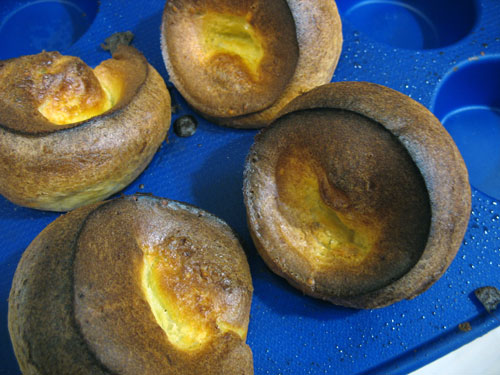
I dig popovers. No leavening at all, just steam.
Popovers Make 1 dozen popovers 1 cup all-purpose flour 1/4 teaspoon salt 1 tablespoon sugar 1 tablespoon melted butter or vegetable oil 1 cup milk 2 eggsPreheat oven to 375 degrees. Combine the dry ingredients and mix well. Combine the wet ingredients and mix into the dry ingredients until you have a very smooth batter. You can use an electric mixer or eggbeater to do this, do it by hand, or even mix it in a blender.
Pour the batter into greased muffin tins. The tins should only be about half full.
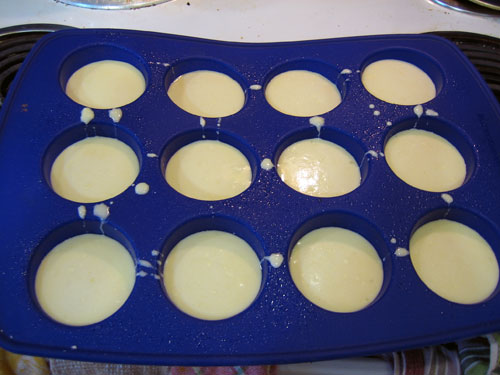
For a light-colored, drier popover, bake at 375 for 50 to 55 minutes. For a darker, crustier but moister in the inside popover, bake at 400 degrees for 40 minutes (as I did in this batch).
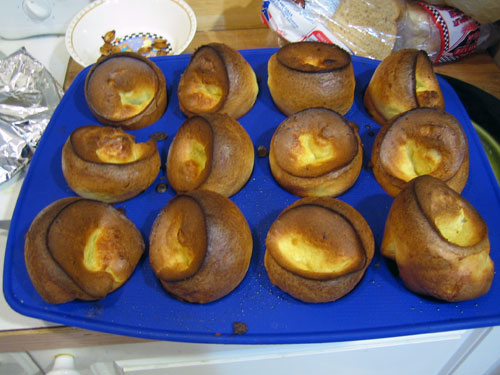
Remove from the oven and eat while hot with jam or butter.
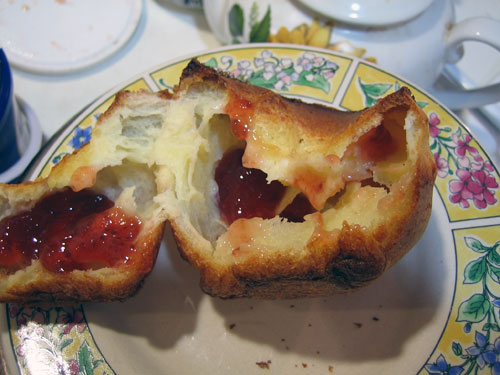

Con Pane Rustic Breads & Cafe 2750 Dewey Road, Suite 105, San Diego, California 92106
Hours:
Closed Wednesdays
M-F: 7:00am - 6:00pm
Sat: 8:00am - 6:00pm
Sun: 8:00am - 4:00pm
24 varieties of Artisan breads including Traditional French Baguettes, Pain au Levain, Artisan Multi-Grain, Raisin and Hazelnut Batard, Gruyere & Chive Boule, and Pane Cioccolata.
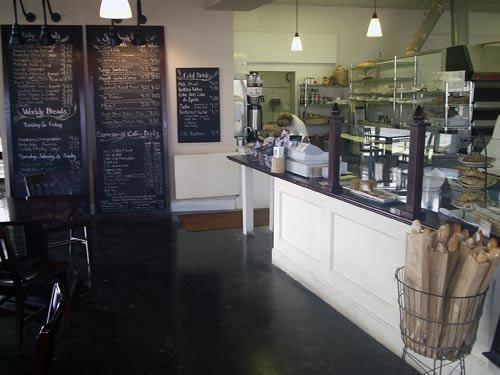
Also, brioche cinnamon rolls and chocolate twists, scones and cookies as well as hugh innovative sandwiches and coffee and espresso drinks.
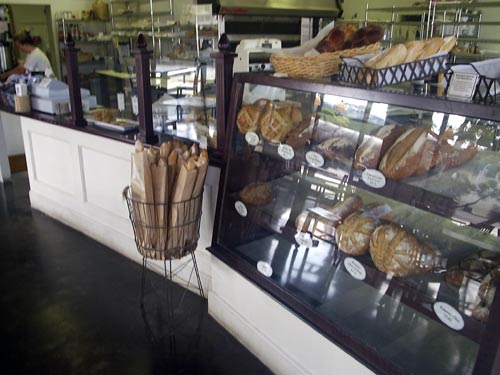
Find it on the bakery finder.